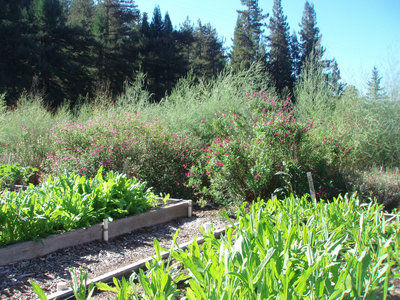
My friend Janie shares with me some of the vegetables she gets in her weekly community-supported agriculture box. I like leafy greens, while she devours the peppers, lettuces, potatoes, beans — whatever is in season and harvested fresh and delicious that week.
Recently, I’d heard about a fabulous place in the Ben Lomond hills, so I called Linda Butler, the owner of Lindencroft Farm, to arrange a visit. I learned so much from Linda, who took time out from running the farm to show me around.
Linda and her husband, Steven, started the farm in 2007. Their 90 acres are zoned as mixed agriculture, but because some of the land encompasses rare Ben Lomond sand hills habitat, they farm just a couple of acres. They have even installed a wide deer corridor separating the growing areas to allow the deer to reach their feeding and watering places. Tall fences protect the beds from other critters, but the Butlers encourage birds and bees by planting flowers that attract beneficial insects and produce seed.
Linda has recently installed a couple of bee hives, too. She became interested in bees when native bees swarmed the property three years in a row. She put up boxes one year hoping they would set up housekeeping on the farm, but they failed to come again. Undaunted, she bought some honeybees, and the hives are doing well. She doesn’t plan to harvest their honey; she just likes bees.
The Ben Lomond sand hills are an amazing ecosystem, and the native plants have adapted to the pure white, fine sand. Vegetables, however, like rich soil that’s not present naturally in the sand hills. The Butlers solved that by creating special raised beds.
After digging down 3½ feet, they laid steel hardware cloth to keep out gophers and built redwood frames that rise 8 to 12 inches around the beds. A blend of organic compost and aged horse manure was used to enrich the native soil, and the whole mixture was shoveled back into the beds. To encourage a healthy soil ecosystem, the Butlers never till or disturb the beds, except by adding more compost between crops to replace depleted nutrients.
Asked why the beds are all so deep, Linda explained that she rotates crops regularly and wants to be able to plant deep-rooted vegetables, such as tomatoes, anywhere she wants. There are now 200 beds in production, ranging from 8 by 12 feet to 100 by 38 feet.
For the first couple of crops in a new bed, she grows leafy greens to establish beneficial microbes in the soil. Larger vegetables come later, and, as she doesn’t till the soil, the microbes aren’t disturbed in any way. She also uses liquid kelp and compost tea for foliar feeding and as a soil drench. Fish bone meal — not fish meal, which is too high in nitrogen — is also applied to crops.
Starting by supplying just a few playgroup moms, the farm now grows produce for two restaurants and harvests enough for a limited number of CSA boxes. A chef from one of the restaurants braises Lindencroft Farm chicory, a bitter green, and serves it under rich meats. Another chef makes sausages from grass-fed beef and sweetens them with the Butlers’ bronze fennel tops and young, fresh seed. Those who subscribe to a weekly CSA box enjoy a different mix: lettuces, chard, cole crops, peppers, tomatoes and herbs, to name just a few.
For information about the CSA, contact Linda via the farm’s website, www.lindencroft.com, by email at li*********@***il.com or by calling 206-7126.
In next week’s column, I’ll delve into how Linda grows all that wonderful produce and which varieties are her favorites.
Jan Nelson, a landscape designer and California certified nursery professional, will answer questions about gardening in the Santa Cruz Mountains. E-mail her at ja******@*ol.com, or visit www.jannelsonlandscapedesign.com to view past columns and pictures.











